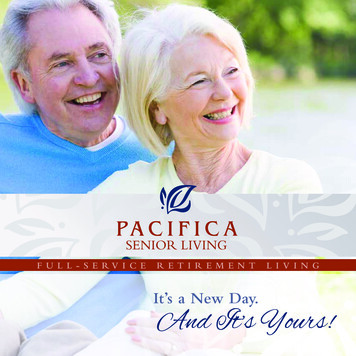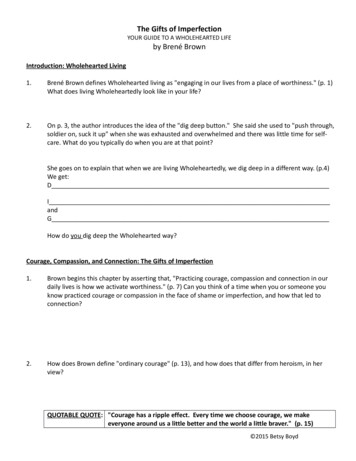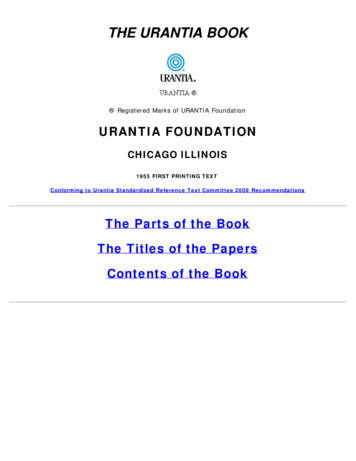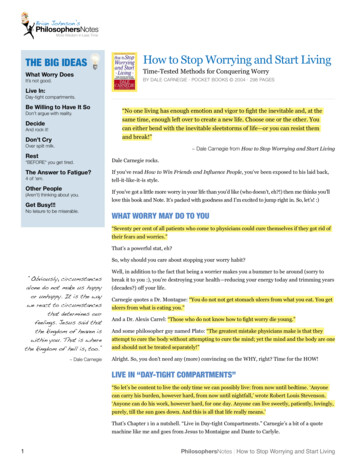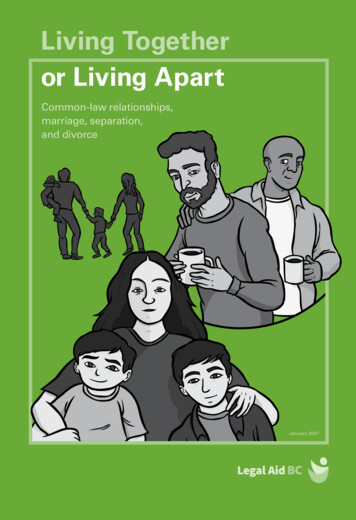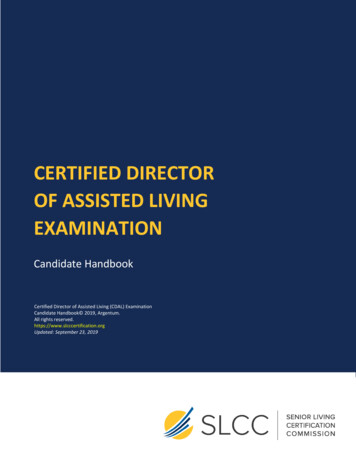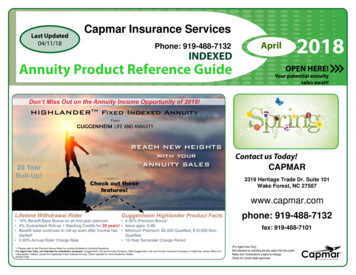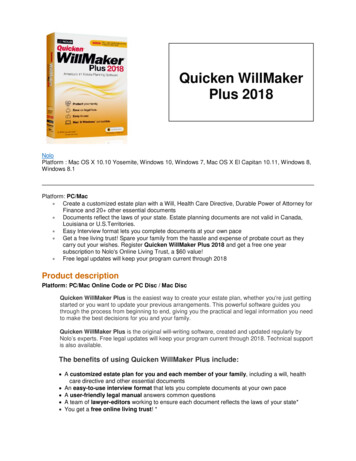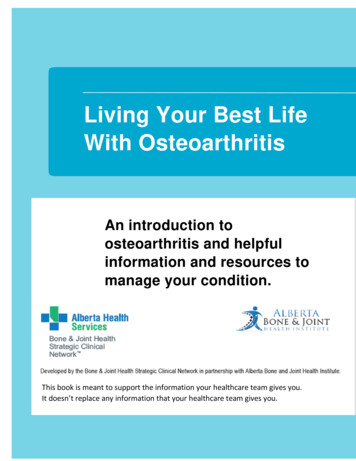
Transcription
Living Your Best LifeWith OsteoarthritisAn introduction toosteoarthritis and helpfulinformation and resources tomanage your condition.This book is meant to support the information your healthcare team gives you.It doesn’t replace any information that your healthcare team gives you.
What’s InsideArthritis and Osteoarthritis (OA) . 1What makes up a joint? . 2What happens to the joint with OA? . 2What are the symptoms of OA? . 3How is OA diagnosed? . 3Are there risk factors? . 4Managing Osteoarthritis (OA) . 4What are some ways I can learn to manage my OA? . 5How can I manage my hip and/or knee OA? . 5Activity and Exercise . 6When You’re Afraid to Move . 7Exercising When You Have Pain . 7Exercising When You Have OA . 8Healthy Eating . 9Weight and OA . 9Know Your Portions . 10Nutrition for Bone Health. 11Managing Pain . 12Mental and Emotional Well-Being . 15Managing Stress, Depression, and Anxiety . 16General Wellness . 17Sleep. 17Dental Health . 18Quitting Smoking . 18Web Resources . 19Notes . 19Supporting Tool #1: Patient Report Card . 20Supporting Tool #2: Treatment Menu for Patients Living with Osteoarthritis . 22
Over 4.4 million people in Canada have osteoarthritis (OA). In 2010, 1 out of every8 people had OA. By 2040, 1 in 4 people will have it. In the next 30 years, therecould be over 10 million people in Canada with OA. This is mainly because 1) thepopulation is getting older, and 2) we’re not as fit as we used to be.Learning more about your condition and taking an active part in your treatment isimportant. This booklet will help you understand your OA better and learn whatyou can do to manage it.Arthritis and Osteoarthritis (OA)Arthritis is a joint condition. There is often pain, swelling, and stiffness. It’s calleda progressive disease because it doesn’t go away and it can get worse. OA is themost common form of arthritis.OA affects each person differently. Some have a lot of symptoms and jointchanges, others not as much.Two different types of arthritis are OA and inflammatory arthritis. It’s possible tohave more than one type.Osteoarthritis Most common form.Can still have some inflammation. Can affect any joint. Most common in the: hips knees hands & fingers spine feet shouldersInflammatory arthritis Examples are rheumatoid arthritisand psoriatic arthritis. Autoimmune, which means thebody’s immune system attacks itsown tissue. Can be seen in the: neck wrists jaw hands & fingers shoulders knees elbows ankles & feet1
What makes up a joint? Joint: Where 2 bones meet. Articular Cartilage: The tough elasticmaterial that covers and protects theends of bones. It allows the bones tomove smoothly over each other. Synovial membrane: Lines the insideof the joint capsule. Has a lubricantcalled synovial fluid, which helps thejoint move smoothly. Muscles and their tendons: Musclesmove your bones and tendonsattach the muscle to bone. Joint capsule: Encloses the joint. Ligaments: Stop the joint from moving in unwanted directions.What happens to the joint with OA?OA happens when the cartilage breaks down faster than the body rebuilds it. Ascartilage breaks down, the bones rub together and damage the joint.This damage can cause pain, as bones contain nerves. Sometimes little bonygrowths, or spurs, develop on the ends of the bones.The joint capsule and ligaments may stretch due to swelling. If this happens, theligaments don’t go back to their original length. This can cause the joint tobecome unstable. You may hear your joints click, crunch, or crack.The increase in fluid from inflammation can cause the joint to feel stiff andpainful. Over time, the cartilage begins to fray and may even wear away entirely,causing your bones to rub against each other.2
Healthy Knee JointNotice how big the joint spaceis, so the cartilage doesn’t rubtogether.Inflamed Knee JointNotice how small the jointspace is, so the joint surfacerubs together.What are the symptoms of OA? Stiffness in a joint when you awaken. Trouble moving or using the joint(s) because of pain, stiffness, or swelling. An achy feeling in the joint(s) during or after exercise. More cracking, creaking, or crunching when you move your joints.How is OA diagnosed?X-rays aren’t needed to make an OA diagnosis. We now know that it can take10 to 15 years for OA changes to show on an x-ray. A healthcare provider’sexamination, as well as reviewing symptoms and risk factors is just as good as anx-ray at diagnosing OA. Assessment, diagnosis, and treatment of OA does notrequire magnetic resonance imaging (MRI).3
Are there risk factors?There are some risk factors you can change, and some that you can’t.What I can change What I can’t change Preventing injury.Age – more common in people over 40.Repetitive movements.Sex – more common in females.The force on our joints related to extraHeredity – a family history.body weight.A pound matters:For every extra pound of bodyweight, there is 4 to 6 timesmore force through the kneejoints.Managing Osteoarthritis (OA)People who cope best with OA are those who learn how to manage it. You knowyourself best and are the best judge of what will work for you.With any chronic condition like OA, there is no one thing that will ‘fix’ or cure it,but there are many activities and strategies that can help you manage your jointhealth.4
What are some ways I can learn to manage my OA?You can: Learn more about OA and any other chronicconditions you may have (keep reading thisbooklet!). Learn more about lifestyle changes that canhelp you manage your OA. Set priorities and take action. Understand that managing OA can sometimes be a challenge. Talk to someoneyou trust or your healthcare team if you have challenges that are getting in theway.One thing at a time,One step at a time,Adds up over time.If you’re ready to make a change, start with 1 or 2 goals and break them downinto smaller steps. It can be hard to make changes if we try to make too manychanges at once. Ask yourself Step #1Why is taking action important to me?Step #2What will help me the most right now?Step #3What can I do to reach my goals?Step #4What can I do in the next 2 weeks?Step #5Check back to see how it went.How can I manage my hip and/or knee OA?Although there’s no cure, there are many things you can do to improve how youfeel and move. Learn all you can about how to take care of the affected joint(s). Learn what helps or doesn’t help you manage your joints. Talk to your doctor about what you’ve learned and how it’s helping.5
Below are the best treatments for OA: Activity and exercise Healthy eating Managing pain Mental and emotional well-being Supportive therapies (like physiotherapy, braces, heat/cold)Activity and ExerciseHow much the OA affects a joint doesn’t always line up with your level of pain, orhow much trouble you’re having moving (mobility). Some people are surprised tolearn they have OA because they are functioning well, while others are surprisedthe changes to their joints aren’t that bad even though they’re having a lot ofpain, trouble moving around, or using the joint.Moving a sore joint sometimes seems like the opposite of what we should dowhen we have a sore body part. However, we now know that staying active withthe right type of exercise is an important part of keeping joint(s) as healthy aspossible.Movement and exercise can lower your pain and help you move better. This isbecause moving and exercising affected joints slows the damage done to thejoint. Strong muscles around the joint can stabilize it, slowing the tissue changesto the joint. Exercise keeps our other body systems healthier (heart, lungs,muscles, bones).Exercise is different from the regular activities you do every day. Exercise ispurposeful and repetitive activity that’s done for a reason and has a goal.Exercise is also different from work. Work can be strenuous and physical, but thatis not the same as therapeutic exercise for OA.6
When You’re Afraid to MoveIt’s common for people in chronic pain to be afraid to move. When youunderstand why movement is important for your joint health and how it helpsyou maintain your lifestyle, it helps you deal with the fear.Tips to try: Talk to someone you trust: Chronic pain or even having a joint that’s reallysore right now can make you feel anxious, afraid, or frustrated. Focus on the positive: No one can do this all the time, but when you feel youneed a lift, focus on a positive thought to make you feel better. Ask for help: Sometimes we need to ask others to help us; sometimes we needthe support of a healthcare professional who can listen to our concerns.Exercising When You Have PainDon’t let pain or the fear of causing pain stop you from being more active orexercising. You can use pain as a guide, even when you have pain before youexercise.1. Start by measuring your ‘baseline’ pain. Baseline pain is rating the intensity ofpain and noting the location on your body. Rate the pain between 0 and 10 (0 no pain; 10 the worst pain you can imagine) and where you feel it.2. Do an exercise. For example, try walking for 10 minutes on a flat surface (like asidewalk).3. Once you complete your exercise, re-rate your pain and its’ location.If the pain is back to baseline within 24 hours after you did the activity, keepgoing with this activity.If your pain isn’t back to the baseline within 24 hours, the activity you did mayhave been too much for your joint. If you walked for 10 minutes on a flatsurface, next time try walking for 5 minutes.7
Take some time to make choices around day-to-day activity (like walking andstanding) and exercise: Try to find a balance between both.Try to plan to exercise earlier in the day. If you leave it to the end, you’re lesslikely to exercise.Exercising When You Have OAExercise is an important part of good health and the health of your joints.Different types of exercise have different effects on the body, so mixing up thetypes of exercise is helpful.Cardiovascular exercises (heart and lung): This type of exercise makes us breathe harder andfaster, and increases blood flow to our heart andlungs. Examples include walking, biking, swimming,cross-country skiing, urban poling, and aerobics. When you have OA, short bouts of exercise, suchas 10-minutes, can give health benefits while tryingto keep symptoms manageable.Try to work up a sweat. If exercise is new to you, 45 minutes per week ofexercise that makes us breathe harder is something to work toward. Strength exercises: This type of exercise is for the muscles around the joint andin our abdomen and back. Examples include abdominal exercises, hamstring andquadriceps strength exercises, hip and gluteal (butt) musclestrengthening.8
Range of Motion (ROM) exercises: Moving through your joints’ range of motion is agood place to start. Stretching the muscles aroundthe joint keeps the joint mobile and muscles relaxedand flexible. It’s often best to stretch and do ROM exercises afteryou’re done with your strength and/or cardiovascularactivity and your body has warmed up. Examples include Yoga and tai chi.Speak with a physiotherapist or exercise specialist if you aren’t sure whatexercises would be best for you or if you haven’t exercised in a long time.If you have any other medical conditions or you’ve never exercised before, speakto your family doctor before starting.Motion is lotion.Lorimer Mosely, Australian Pain ScientistHealthy EatingWeight and OAPeople with OA also often carry extra body weight. Extra body weight puts moreforce on the knees and hips. Eating healthy and being active are parts of a healthylifestyle for managing chronic disease.The next page has information about making healthy food choices. If you carryextra weight, there are some helpful tips to stop you from gaining more weight.After that, you can focus on losing a small amount of weight at a time: Evenlosing a little of that extra weight can lessen joint pain. Talk to your healthcareproviders about your goals for health and weight.9
Know Your PortionsHow much you eat is as important as what you eat.You can gain weight if you eat and drink larger portionsthan you need. Make it a habit to eat a variety ofhealthy foods each day.Creating healthy meals and snacks can be simple whenyou use the Eat Well Plate from Canada’s Food Guide. Make half your plate vegetables and fruits.o Vegetables and fruits should always make up the largest proportionof the foods you eat. Divide the other half of your plate into smaller portions of Grain foods andProtein foods.o Choose whole grain foods. Whole grains are a healthier choice andhave more fibre.o Choose protein foods such as beans, lentils, nuts, seeds, lean meatsand poultry, fish, shellfish, eggs, lower fat milk and lower fat dairyproducts. Include protein foods that come from plants more often. Make water your drink of choice.o Replace sugary drinks with water Other healthy drink options can include:o Plain milk (unsweetened lower fat milk), unsweetened fortified plantbased beverages such as soy or almond beverage and unsweetenedcoffee and teas Limit drinks high in sugar and calories like:o popo alcoholic drinkso juiceo energy drinkso iced teao coffee and tea drinks made withsugar, syrups, cream and whitenero fruit-flavoured drinkso slushiesFor more information, visit Canada.ca/Food Guide.10
Record what you eat and drink. People who keep track of what they eat and drinkare more likely to make changes that last.Healthy eating may help you control some of your symptoms and manage sideeffects from some of the medicine you take for your OA. You’re going to comeacross a lot of books and websites that claim that some foods or special diets orsupplements will cure OA or help with symptoms. However, many studies haveshown that no one food, diet, or supplement will cure OA.Don’t follow diets that ask you to stay away from certain foods. Doing this couldcause you to get less of the nutrition you need to stay healthy. If you’re thinkingabout cutting out healthy foods or changing the way you eat, speak with yourdoctor or a dietitian first.Nutrition for Bone HealthBone health is also affected when a joint breaksdown.When you have OA, ask yourdoctor or dietitian about theamount of vitamin D andcalcium that’s right for you.To ensure your best bone health, look to see ifyou’re getting enough calcium and vitamin D inyour diet. Include foods that are good sourcesof vitamin D in your diet AND take a vitamin D supplement.Below are the suggested levels of calcium and vitamin D a person needs in a day.AgeVitamin D (IU/day)Calcium (mg/day)18 – 49 years400 - 1000 IU1000 mg50 or over and healthy1000 IU1200 mg50 or over with risk foror diagnosis ofosteoporosis1000 IU -2000 IU1200 mg11
Foods high in calcium include:Milk or fortified soy beverage, 1 cup (250 mL) (whole,2%, 1%, skim)300 mgHard Cheese 1.5 oz. (50 g) (cheddar, edam, Gouda)245 mgAlmonds, ½ cup (125 mL))186 mgFruit-flavoured yogurt, ¾ cup (175 mL)Yogurt, plain ¾ cup (175 mL)200 mg300 mgSalmon, canned with bones 2.5 oz. (75 g)200 mgCalcium fortified orange juice, ½ cup (125 mL)150 mgTofu made with calcium, 3.5 oz. (105 g)300 mgSource: Osteoporosis Canada 2010Managing PainPain medicine won’t make all the pain your OA causes go away. The goal of painmedicine is to lower the pain to a level where you’re more comfortable, canexercise and move better, and have a better quality of life.Always take the medicine as directed. Speak with your doctor or pharmacist if youhave any questions about your pain medicine.Pain medicine works best when you also manage your pain through lifestylechanges like regular exercise, learning ways to manage stress, and learning how toconserve your energy.Your healthcare providers, including your pharmacist will talk to you about whatstrategies are right for you based on your health.12
Medicine that can help you manage your pain: Topical creams (e.g., capsaicin, diclofenac) Non-steroidal anti-inflammatories (NSAIDs) (e.g. naproxen, diclofenac,ibuprofen,) Serotonin-norepinephrine reuptake Inhibitor (SNRI) class antidepressants (e.g.,duloxetine) Intra-articular joint injections (e.g., cortisone, hyaluronic acid)A trial of acetaminophen (e.g. Tylenol ) may help you decide if it helps with yourOA pain. Evidence suggests that it is not harmful to try and may work for some.Glucosamine, a natural health product, doesn’t rebuild your cartilage or makeyour joint healthier. However, some people do find that it helps with theirsymptoms.Some treatments are not recommended because we don’t know enough aboutthem. These include: Intra-articular platelet rich plasma (PRP) Intra-articular stem cell therapyNon-medicine ways that can help you manage your pain: Hot or cold packs Heat or cold can help relieve jointdiscomfort. When using ice use a towel between the icesource and your skin. Don’t leave the ice longer on than 20minutes at a time.If you have poor circulationor less sensation in thearea, be careful when usingheat or ice to prevent aburn or frostbite.Physiotherapy Can help you get more movement and function. Can help you progress to more advanced exercises.13
Pacing yourself and conserving your energy Set your priorities for the day so you don’t do too much. Plan rest between activities; even 5 minutes of rest can help. Do your activities at the time of day when you have the most energy. Don’t sit or stand too long at a time—changing your position often can helpmanage symptoms (e.g. sit on a stool when preparing a meal). Use assistive devices (e.g. a rolling cart to carry groceries). Plan walks for places where there are benches.Break up your activities throughout the week so that you don’t overdo it inone day. Bracing and Mobility Aids A brace can help stabilize your joint. Some are designed to take pressure offareas of the joint. Custom braces: Your family doctor will have to refer you to a certifiedorthotist. A custom brace will cost money to make. If you have medicalinsurance, check with your insurer to see if you’re covered. Over-the counter-braces: Medical supply stores carry knee braces. Manystores let you try on the brace before you buy it.Walking aids, like a cane or walker can help if your hip and/or knee OA affectshow well you move. Hold the cane in the hand opposite to the painful joint (e.g., for left kneepain, hold the cane in your right hand). If you’re not steady with a cane orfind yourself holding onto the walls or furniture for support, a walker maybe a better choice for you.Insoles or shoes Shock-absorbing shoes or gel or silicone insoles may help reduce hip andknee pain for some people.14
Mental and Emotional Well-BeingPhysical, mental, emotional, and spiritual health are all related. Improving yourwellness in one area can help with the others.Mental health is a positive sense of well-being or feeling like you can enjoy lifeand manage challenges. Good well-being doesn’t mean you won’t face challengesor feel upset at times—it means you can cope when faced with those feelings orsituations.Things to help with your well-being: Connect: Spend time with the people you care about. Develop theserelationships or new ones too. Join a group if one interests you. Be Active: You’ve heard it before, but staying active is not only good for yourbody, but also helps your mind stay well. Keep Learning: Take time to learn a new skill—it might be something that’sgood for your health or helps you feel better about yourself. Give Back: Small gestures can have a big effect: give someone a smile orvolunteer.Be Mindful: Pay attention to the right now—your thoughts, feelings, or howyour body feels. This ‘mindfulness’ can change the way you feel about life andhow you approach challenges. Live your Balance: Figure out what’s most important to you and make it apriority. You can’t and won’t be able to do everything, all the time, foreveryone.15
Managing Stress, Depression, and AnxietyStress is a normal part of life—having a chronic condition can cause more stress.Tips to try: Know your signs of stress and ways to cope with it. Ask for help if you findyourself using unhealthy ways to cope (like eating, drinking, or smoking more).That way, you may be able to make changes before the stress becomes toomuch. Ask for help. This could be from family, friends, your healthcare provider, or anorganization. Plan your time, learn to say ‘no’, or try a different way to do something.DepressionEveryone feels ‘low’ or sad from time to time. Thisdoesn’t mean that you’re depressed. Depression maybe a problem if you feel sad, unhappy, or miserablemost of the time for longer than 2 weeks.Talk to your doctor if you think you’re depressed, asit can be treated!If you feel like hurtingyourself or someoneelse, call 911 or go tothe closest emergencydepartment.AnxietyAnxiety is the worry about what may happen in the future. Counselling or bothcounselling and medicine can help with anxiety. Talk to your doctor about theoptions that are best for you. Getting help is important!Where can I get help for my mental, emotional, or spiritual health? Mental Health Crisis (e.g., thoughts of harming yourself or others): 911 Mental Health Help Line (24/7): 1-877-303-2642 (toll-free) Your primary care provider: doctor, nurse, or rehabilitation professional Health Link: 811 (24/7)16
General WellnessSleepSleep is an important part of your physical and mental wellness. Not gettingenough sleep can affect your mood and how you feel overall. Sleep is importantbecause: it helps your body heal helps you better cope with stress and anxiety gives you the energy you need for daily activity it boosts overall healthTips for falling asleep and staying asleep Avoid napping during the day: Napping during the day makes it harder to fallasleep at night. Set a regular bedtime: A routine will help your body know when it’s time tofall asleep. Set an alarm 1 hour before bedtime to remind you to start your bedtimeroutine. If you take pain medicine at night, take it at this time. Use ice or heat: Use your ice or hot pack right before bedtime. Electronic devices: Turn off 1 hour before bedtime. Sleep in a dark room: Bright or artificial lights from electronics like a tablet,cell phone, or TV can affect your sleep cycle. Avoid alcohol: Alcohol affects sleep. While you may fall asleep easily, alcoholaffects the part of the brain that helps you stay asleep. Mixing alcohol and painmedicine is never a good idea. Sleep aids: If you’re thinking about taking medicine to help you sleep, speak toyour pharmacist or doctor about what sleep aids are safe for you.17
Fluids: Stop drinking fluids at least 1 hour before bedtime so you don’t wakeup in the night or as many times in the night to use the washroom. Caffeine: Limit caffeine to no more than 400 mg each day—about 3 cups ofcoffee. Many teas, sodas, and chocolate have caffeine in them. Keep the room cooler: Open a window a little, turn the heat down, or turn ona fan can help you sleep. Background noise: Sometimes soft ‘white noise’ can help people fall asleepand/or stay asleep (examples: fans, humidifiers, nature sounds). Keep a journal or notepad beside your bed: Write down any thoughts orworries that are keeping you awake. After 20 minutes of trying to fall asleep: Get out of bed and do a relaxing, quietactivity until you feel tired.Dental HealthA healthy mouth affects your overall health: Get regular check-ups with a dentist. Take care of any dental issues.Quitting SmokingSometimes we don’t think about how smoking affects other parts of our bodyother than our lungs. Smoking affects the blood flow in your whole body,including to your bones and joints. If you smoke and you’re thinking aboutquitting, now is the time. Bringing your body back to its best health will help youmanage your OA even better.18
Web Resources My Health Alberta:myHealth.Alberta.ca Healthier Together – ons/osteoarthritis Alberta Health Services Nutrition:ahs.ca/nutrition GLA:D (Good Life with osteoArthritis: Denmark, adapted for Canada):gladcanada.ca Arthritis Society:arthritis.caThis book is meant to support the information your healthcare team gives you. Itdoesn’t replace any information that your healthcare team gives you.For 24/7 nurse advice or general health information, call Health Link at 811. Forrehabilitation advice and to talk to an occupational or physical therapist, call theRehabilitation Advice Line toll free at 1-833-379-0563.Notes19
Supporting Tool #1: Patient Report CardPeople with osteoarthritis (OA) can learn to manage their condition with support from their healthcare providers.Circle how well you think you manage your OAI need help!Circle how much you think you know about OAConfident self-managerDon’t know very muchI’ve got thisNo one thing will ‘fix’ or ‘cure’ OA, but there are things you can do to manage your joint health.Check what you’ve already tried—or not—before to keep your joints healthy:Things You Can Try to Manage Your OALearn more about OA and how to manage it(examples: GLAD program, Alberta Healthy Living Program, Arthritis Society)Exercise on land(examples: GLA:D program, walking, biking, strength training, physical therapy)Exercise in water(examples: swimming, aquacize, deep water work outs)Weight management and nutrition(examples: dietitian consult, weight management program, cognitive behavioural therapyJoint protection(examples: knee bracing, foot insoles, assistive devices)Walking aides(examples: cane, walker, Nordic poles)Mental health support(examples: counselling, meditation, cognitive behavioural therapy, group support)Pain medicine(topical anti-inflammatories (NSAIDS), oral anti-inflammatories, joint injections)20Yes – triedNo – haven’t tried
Lifestyle change isn’t easy! What motivates you to improve your pain and mobility? Keep this in mind as you make a plan toimprove your pain management and mobility.Example: I really want to improve my mobility so that I don’t have to ask others for help.Your motivator:The more important managing your OA is to you, the better you’ll know how to manage it. Managing OA is part of yourday-to-day lifestyle choices so it’s important to know what your challenges may be.Check off YOUR challenges: I don’t have enough time I don’t have enough money I have too many other responsibilities to focus on my own health I don’t know where to start OtherLet’s come up with some plans on how to deal with your challenges:Plan:Plan:Plan:21
Supporting Tool #2: Treatment Menu for People Living with OsteoarthritisEducation and SelfManagementLand basedExerciseGroup classesOnline supportCounsellingWalkingCyclingCross CountrySkiingDeep waterworkoutPrivate WeightManagementprogramsWater ult (1:1 orgroup class)Low ImpactWater aerobicsPublic WeightManagementprogramsDietitian 1:1ConsultPublic educationprogramsPrivate educationprogramsOA GroupexerciseprogramPhysicalTherapist 1:1CommunityrecreationprogrammingNutritionStrength ExercisesJoint ProtectionWalking AidsPain ManagementKnee braceKnee sleeveFoot orthoticsCaneNordic WalkingpolesWalkerHeat or rapy (CBT)Other*Requires physician consultation22YogaTai ChiAqua-cycleAqua-walkingLow impactAerobicsOA BT)PrivatenutritionalcounsellingHome exerciseprogramSpecializedfootwearOT or PTfor ROM andjointprotectionideas*Topical NSAIDs*Oral NSAIDs(e.g. diclofenac)(e.g. ibuprofen,naproxen)*Corticosteroidinjection*HA Injections(e.g. Durolane ,Synvis
Living Your Best Life With Osteoarthritis An introduction to osteoarthritis and helpful information and resources to manage your condition. This book is meant to support the information your healthcare team gives you. It doesnt rep
